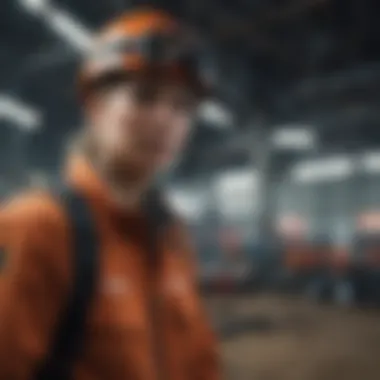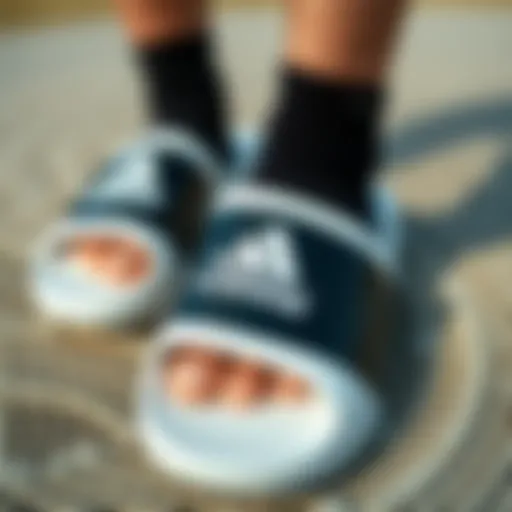C4 Construction in Extreme Sports: A Detailed Analysis


Intro
C4 construction is a term that may not be widely recognized outside the realm of extreme sports, yet it plays a crucial role in shaping the environments where thrill-seekers push their limits. This article explores the intricate relationship between C4 construction methods and extreme sports, emphasizing how innovative design and materials enhance safety, performance, and sustainability. We will navigate through various components, including specific methodologies, important features, and case studies that highlight the practical ramifications of C4 construction within these high-stakes disciplines.
Extreme sports encompass a diverse range of activities, from rock climbing to BASE jumping, each with its own unique requirements and challenges. The principles of C4 construction provide tailored approaches for creating infrastructures that not only meet these demands but also elevate the overall experience for participants. By examining how these techniques apply to extreme sports, readers will gain valuable insights that extend beyond standard construction practices.
From understanding skill development to exploring the latest gear, this article aims to serve as a comprehensive guide. The importance of safety measures and best practices will also be underlined, ensuring that enthusiasts can engage in their favorite activities while minimizing risks. As we delve deeper into each section, we will highlight key components and the relevance of C4 construction, ultimately synthesizing this information to present a holistic view of its impact on extreme sports.
C4 construction offers a framework that is adaptable and responsive to the evolving needs of extreme sports environments, fostering innovation and safety.
In the following sections, we will systematically unpack the various aspects of C4 construction in extreme sports, allowing for a more profound understanding of how these construction methodologies intertwine with adventure activities.
Preamble to C4 Construction
C4 construction plays a vital role in the landscape of extreme sports. Understanding this construction approach is essential because it links architecture directly to performance and safety in challenging environments. In extreme sports, where the stakes are high, the integrity of the facilities used cannot be compromised. C4 construction offers unique solutions tailored for such demands, prioritizing sustainability, safety, and performance.
With the rise in popularity of extreme sports, there has been an increasing need for specialized facilities. These establishments must withstand not only the test of time but also the rigors of extreme weather and the impact of high-energy activities. Therefore, this construction methodology is crucial.
Defining C4 Construction
C4 construction refers to a specific construction philosophy that integrates advanced materials and engineering techniques. The "C4" denotes four key concepts: compositional, contextual, collaborative, and constructible. This means that every project considers its surroundings, engages different stakeholders, and utilizes the latest materials and construction methods to ensure safety and usability. This approach aims for optimal performance in extreme environments, such as skate parks or climbing walls.
One feature that distinguishes C4 construction from traditional methods is its adaptability. Projects can be designed to evolve over time, responding to new challenges and technologies in the extreme sports arena. This flexibility is crucial, as it allows for ongoing enhancements and modifications, thereby extending the lifespan and functionality of the structures.
Historical Context and Evolution
C4 construction has not always existed as a structured methodology. Initially, extreme sports facilities were built with limited understanding of their unique demands. Early skate parks and surfing areas often faced structural issues and safety hazards. Over time, it became clear that a specialized approach was necessary.
In the late 20th century, the growth of extreme sports led to innovative breakthroughs in construction techniques. Designers started to collaborate more with athletes, ensuring venues catered to specific needs. The introduction of C4 construction marked a turning point, emphasizing integrated design processes and advanced materials. With advancements in technology, tools like 3D modeling and computer simulations allowed for enhanced planning and execution.
Today, understanding the historical evolution of C4 construction is crucial for appreciating its significance in extreme sports. It illustrates how adaptable and forward-thinking construction methodologies have changed the way facilities are designed and built. This evolution reflects a growing awareness of the intersection between sports performance and architectural integrity, shaping the future of active leisure environments.
Key Components of C4 Construction
Understanding the key components of C4 construction is essential for exploring its application in extreme sports. This section highlights the significance of materials, design principles, and innovative techniques that play a crucial role in creating safe and efficient structures. These components not only enhance the experience for participants but also reflect an advanced approach to construction that meets the demands of extreme sports environments.
Materials and Their Properties
The selection of materials is a pivotal aspect of C4 construction. The properties of materials directly influence the durability, safety, and performance of a structure. In extreme sports, where conditions can be unpredictable, it is necessary to choose materials that can withstand environmental stresses.
Common materials used in C4 construction include:
- High-Performance Concrete: This offers increased strength and durability, essential for facilities subjected to significant wear and tear.
- Reinforced Steel: Common in skate parks and climbing walls, it provides structural support and guarantees longevity.
- Sustainable Materials: Innovations like bamboo and recycled plastics are becoming more popular, aligning with the growing emphasis on sustainability in construction.
Each material serves a specific purpose, ensuring that structures not only endure but also perform optimally during use. The interaction of different material properties must be carefully considered to avoid potential failure points.
Design Principles for Safety and Performance
Designing with a focus on safety and performance is non-negotiable in C4 construction. Extreme sports involve inherent risks, and a well-thought-out design can mitigate these dangers. The following principles are crucial:
- User-Centric Design: Structures should accommodate various skill levels, ensuring both novice and experienced users can safely engage in activities.
- Dynamic Load Management: Anticipating the forces that will act on a structure during use allows for better resilience. For instance, ramps for skateboarding must account for the impact of tricks and jumps.
- Emergency Access and Egress: Facilities must include clear pathways for emergency services while making sure participants can exit safely in case of an incident.


By adhering to these design principles, C4 construction can enhance the overall experience while prioritizing safety. The integration of performance metrics into the design phase can also lead to improvements in user satisfaction and engagement.
Innovative Construction Techniques
Advancements in construction technologies offer numerous opportunities for enhancing C4 construction. The use of innovative techniques can streamline building processes and improve structural integrity. Key techniques include:
- Modular Construction: This involves prefabricating sections of a structure off-site, allowing for faster assembly and improved quality control.
- 3D Printing: Increasingly utilized for creating custom components, this method reduces waste and allows for intricate designs impossible with traditional techniques.
- Smart Materials: These materials can adapt to environmental changes, improving durability and reducing maintenance needs. For example, temperature-responsive materials can help maintain optimal conditions within climbing gyms.
Incorporating these innovative techniques not only leads to more efficient construction but also fosters a safer environment for extreme sports activities. Regular assessments and adjustments can optimize functionality and aesthetics.
"Materials, design, and innovative techniques are the backbone of effective C4 construction that meets the unique demands of extreme sports."
With this foundation laid, we can now delve deeper into the specific applications of C4 construction in extreme sports.
Application of C4 Construction in Extreme Sports
The application of C4 construction in extreme sports is pivotal. It combines structured engineering with the dynamic needs of athletes who push the limits. C4 construction helps create environments that are not only safe but also enhance performance. Each element in this methodology is tailored to meet the specific demands of various extreme sports.
When discussing C4 construction in this context, it is essential to consider three main areas: emphasis on safety, innovative infrastructure designs, and sustainable practices. These aspects define how C4 methodologies can lead to improved athlete performance and overall experience during extreme sports activities.
Surfing Facilities and Infrastructure
Surfing facilities represent an essential element in the ecosystem of extreme sports. Built properly, they offer surfers a suitable environment to practice their skills while ensuring safety. C4 construction principles help in designing wave pools, surf parks, and related infrastructures.
Key advantages include:
- Custom Wave Generation: These facilities can generate waves that mimic natural ocean conditions, enhancing training.
- Safety Features: By utilizing load-bearing materials and footwear designs, risks of injury are minimized, ensuring a safer venue.
- Ecosystem Impact: Environmentally conscious designs can help reduce negative impacts on local aquatic ecosystems, benefiting both the sport and environmental health.
In addition to physical features, such facilities often include seating areas for spectators, restrooms, and equipment storage, making them accessible to a broad audience.
Skate Parks and Urban Design
Considered urban art, skate parks serve as community hubs for skateboarding and rollerblading. Implementing C4 construction in these areas supports both the thrill-seeking spirit and the need for safety.
Important factors are:
- Durability of Surfaces: Materials chosen must withstand intense wear from vehicles like skateboards and bikes, ensuring longevity.
- Creative Designs: Unique obstacles and ramps tailored to specific skill levels attract a range of users and help engage the community.
- Integration with Nature: Natural landscaping can enhance the aesthetic, providing a more enjoyable atmosphere for enthusiasts.
Moreover, well-designed skate parks can contribute positively to local neighborhood revitalization, encouraging youth engagement in sports.
Climbing Walls and Adventure Parks
Climbing walls and adventure parks have seen a rise in popularity, fueled by the growing interest in climbing as both a sport and social activity. C4 construction frameworks address several aspects of these environments, ensuring they meet the specific needs of climbers and adventure seekers.
Key components include:
- Structural Integrity: Walls must support multiple climbers safely. Materials used here require thorough analysis and testing to prevent accidents.
- Variety of Challenges: Different routes provide varied difficulty levels for climbers, encouraging skill growth and accessibility for beginners.
- Safety Regulations Compliance: Following safety standards stipulated by national and international regulations is crucial. Regular inspections and maintenance ensure continuous safety for all users.
Case Studies of C4 Construction in Action
The exploration of C4 construction in extreme sports reveals not just theoretical underpinnings, but practical implementations that have significantly shaped the landscape of adventure activities. Case studies play an essential role in this discussion. They provide concrete examples of successes and failures, helping stakeholders in extreme sports understand what works and what can be improved. Through these case studies, we can evaluate performance, safety measures, and the sustainable practices that define effective C4 construction. This analysis also encourages a reflective practice whereby lessons can be drawn from both triumphs and setbacks, ensuring that the practices in extreme sports are continually evolving towards greater efficiency and safety.


Successful Projects in Extreme Sports
Several notable projects demonstrate the effective use of C4 construction within extreme sports. One such project is the Wrightsville Beach Surf Park. This facility incorporates advanced construction techniques and eco-friendly materials to create a state-of-the-art surfing environment. Key benefits highlighted in this implementation include:
- Enhanced Safety: The design ensured that water conditions are safer for surfers of all levels.
- Sustainability: The project used reclaimed water systems and solar panels, which reduced environmental impact.
- Community Engagement: Local athletes were involved in the design process, aligning the facility’s offerings with actual user needs.
Another example is the The Edge Climbing Gym in Pittsburgh. This climbing facility effectively meets the needs of a growing population of climbing enthusiasts. The gym incorporates unique wall textures and angles, which enhance user experience. Critical aspects include:
- Diverse Skill Levels: The climbing walls are designed to challenge beginners and advanced climbers alike.
- Material Durability: The use of long-lasting materials reduces the need for constant repairs.
- Event Hosting: The architecture allows the gym to host competitions, which fosters a sense of community among climbers.
"Successful C4 construction methods prioritize athlete engagement and sustainability while also addressing safety standards."
Lessons Learned from Failed Projects
Not all projects seeking to implement C4 construction have achieved their goals. A prominent example is the failed skate park at Glenwood Springs. Originally envisioned as a haven for local skaters, this facility was closed shortly after opening due to several critical flaws. Insight gained from this project can be summarized as follows:
- Lack of Community Input: Local skaters were excluded from the design process, leading to a facility that did not meet their needs.
- Material Failures: Poor-quality materials led to rapid deterioration of ramps and surfaces, posing safety risks.
- Insufficient Safety Features: The park lacked necessary safety barriers, which resulted in accidents and injuries.
Another case to consider is the Mountain Bike Trail at Timberline Lodge. While the intent was to create a durable and fun trail system, heavy rains soon exposed significant design flaws. Key issues included:
- Inadequate Drainage Solutions: Waterlogged trails led to erosion, making the trails unsafe for riders of all levels.
- Poor Design Choices: The trail’s layout did not consider the various skill levels of potential users, causing bottlenecks and safety concerns.
Sustainability Considerations in C4 Construction
C4 construction intersects with extreme sports at a critical point, where the excitement of adventure must balance with the responsibility towards our planet. Sustainability in this context is not merely a buzzword; it is a crucial component that shapes how new structures are conceived, built, and maintained. Understanding the environmental impact of construction, as well as how to minimize it, becomes paramount.
Environmental Impact Assessments
Before any extreme sports facility can begin construction, environmental impact assessments are vital. These assessments serve as a comprehensive evaluation of how proposed projects might affect local ecosystems. They examine factors such as:
- Air and water quality: Understanding pollution levels and potential disruption to local flora and fauna is essential.
- Biodiversity: Assessing the effects on local wildlife and their habitats ensures that development does not unduly harm the ecosystem.
- Community effects: The projects should also consider impacts on local communities, including increased traffic or noise that might disrupt daily life.
Implementing rigorous assessments fosters awareness and accountability. For instance, a site chosen for a new rock climbing center may need to conduct geological stability studies to prevent erosion, which could have downstream effects on water quality.
Using Eco-Friendly Materials
Eco-friendly materials represent a significant advancement in construction methods have been adopted in C4 construction to minimize the carbon footprint. The focus is on materials that not only serve their practical purpose but also lessen environmental impact. Some noteworthy eco-friendly materials include:
- Recycled materials: Steel and concrete sourced from recycling can significantly reduce demand for new raw materials.
- Sustainable wood: Timber from certified forests ensures that logging does not contribute to deforestation.
- Bamboo: This rapidly renewable material is not only strong but also lightweight, making it ideal for various constructions.
Using eco-friendly materials extends beyond the construction phase. These materials often lead to better energy efficiency, reducing long-term operational costs as well. Facilities that use passive heating and cooling solutions can further emphasize sustainability.
The investment in eco-friendly construction materials pays dividends not only environmentally but also economically in the long run.
Shifting towards a more sustainable model in C4 construction can attract like-minded sponsors and patrons who prioritize environmental stewardship.
By addressing sustainability, C4 construction not only enhances the performance and lifespan of extreme sports facilities but also aligns closely with the values of thrill-seekers and adventurers who often have a deep connection with nature.
The Future of C4 Construction in Extreme Sports
The future of C4 construction in extreme sports holds significant promise. As the realm of extreme sports continues to evolve, so does the approach to their infrastructure. Advancements in technology and innovative design practices will shape the next generation of sporting venues, making them safer, more sustainable, and tailored to meet the demands of various sports enthusiasts. By focusing on emerging technologies, architects and engineers can create environments that foster performance while respecting environmental considerations.


Emerging Trends in Construction Technologies
The construction industry is no stranger to technological advancements, and C4 construction is no exception. Several trends are emerging that are likely to influence the future of structures in extreme sports:
- 3D Printing: This allows for rapid prototyping and construction of complex shapes. In extreme sports, 3D printing can create custom skate parks or climbing walls tailored to specific user preferences.
- Modular Construction: This method promotes efficiency. Sections of sporting venues can be built off-site and then assembled on location, reducing time and labor costs.
- Smart Materials: Innovations in materials science are leading to the development of substances that react to environmental conditions. For example, sensors integrated into the materials can provide real-time data on stress and wear, enhancing safety.
- Virtual Reality (VR) and Augmented Reality (AR): These technologies can assist in both design and training. Designers can visualize projects before construction, while athletes can practice in simulated environments.
These emerging trends suggest that the construction of facilities for extreme sports will become more innovative, collaborative, and responsive to both athlete needs and environmental conditions.
Predictions for the Next Decade
Looking ahead to the next decade, several predictions can be made regarding C4 construction in extreme sports:
- Increased Focus on Sustainability: There will be greater emphasis on environmentally sound practices. This includes using renewable materials, energy-efficient designs, and reducing waste throughout the construction process.
- Integration of Technology: Facilities will likely incorporate more advanced technologies to enhance athlete performance. Smart spaces that collect data on usage patterns can help optimize facility designs.
- Enhanced Safety Protocols: As knowledge about materials and design improves, safety standards are expected to evolve. This will lead to more rigorous testing and certification processes for extreme sports facilities.
- Customization and Personalization: Future venues will likely cater to a wider array of sports and styles. This means more bespoke designs that reflect the specific needs and preferences of sports enthusiasts.
"The key to future-proofing extreme sports construction lies in blending safety, performance, and sustainability."
The future of C4 construction in extreme sports is not just about enhancing the venues but also about responding to the ever-evolving needs of athletes and enthusiasts. As we move forward, embracing these trends will be essential for creating facilities that support and elevate the experience of extreme sports.
Safety Standards and Regulations
Safety standards and regulations play a crucial role in the implementation of C4 construction, especially within extreme sports environments. These guidelines establish a framework that not only assures the security of athletes but also sets benchmarks for quality and performance in construction practices. Understanding these standards helps builders, designers, and sports enthusiasts maintain a safe and functional experience.
National and International Guidelines
National and international guidelines exist to ensure that extreme sports facilities meet specific safety criteria. These regulations are developed by organizations such as the International Organization for Standardization (ISO) and various national bodies. They encompass a range of areas, including structural integrity, user safety, and emergency procedures. For example, the ASTM International standards provide specifications related to a variety of sports equipment and facilities, ensuring that they conform to the highest safety norms.
Complying with these international standards is essential for facilities that want to host sanctioned events. This compliance signifies that the facility adheres to globally recognized safety measures, thus giving athletes confidence while engaging in their sports. Consequently, these guidelines promote a culture of safety, encouraging both participation and investment in extreme sports.
Best Practices for Compliance
To comply effectively with safety standards, it is beneficial to implement certain best practices. Here are some of the key practices that can enhance safety in construction for extreme sports:
- Conduct Regular Safety Audits: Frequent evaluations help to identify hazards and rectify issues before they pose a risk to participants.
- Engage Qualified Professionals: Ensuring that architects and builders are experienced in extreme sports construction can greatly reduce inconsistencies and improve design safety.
- Training and Education Programs: Implementing regular training for staff and athletes on safety procedures is vital. This preparedness can save lives and prevent injuries.
- Incorporate Emerging Technologies: Utilizing advanced materials and design methodologies can aid in creating safer environments. For instance, soft impact materials in skate parks can reduce injuries during falls.
- Facilitate User Feedback: Engaging with users can provide insights into potential safety concerns, thus refining the safety measures applied.
The commitment to safety in extreme sports construction is not just compliance; it is about fostering an environment where thrill-seekers can pursue their passions with confidence.
Finale
C4 construction stands as a pivotal element in the framework of extreme sports, embodying a blend of safety, innovation, and sustainability. This article has illustrated how specific construction methodologies cater to the unique environments of extreme sports, enhancing both performance and the overall experience for participants.
Recap of C4 Construction Significance
Across various disciplines such as surfing, climbing, and skateboarding, C4 construction presents a strong case for its significance. The use of advanced materials and design principles aims to ensure that facilities are not only resilient but also adaptable to extreme conditions. The construction techniques discussed—such as modular designs and eco-friendly materials—offer benefits that extend beyond mere functionality. They promote responsible practices that align with environmental sustainability, allowing for the integration of natural elements while retaining the essence of adventure.
- Enhanced Safety: Rigorous safety standards are ingrained in C4 construction, reducing risks associated with extreme sports.
- Performance Optimization: Thoughtfully designed structures facilitate improved performance outcomes for athletes.
- Sustainability Focus: Eco-friendly materials and designs lower the environmental impact.
The combination of these factors solidifies C4 construction's relevance in the sports community, ensuring not only the evolution of infrastructure but also the enhancement of user experiences.
Final Thoughts on Future Directions
Looking ahead, the future of C4 construction in extreme sports is poised for transformative changes. As sports continue to evolve, so too will the architectural responses to these changes. Advanced technologies like 3D printing and smart materials will likely emerge, fostering innovative designs that can adjust to real-time environmental factors or user experiences.
The ongoing emphasis on sustainability will also influence construction methodologies as the demand for greener approaches rises. As environmental awareness becomes more prominent among sports enthusiasts, constructors will need to innovate more diligently to reduce carbon footprints.
The convergence of technology, safety, and sustainability will lead to the development of new paradigms in C4 construction, confirming its essential role in shaping the future of extreme sports.
"The evolution of extreme sports infrastructure is not a trend, but a necessity that defines our collective future."
To sum, C4 construction carries with it the promise of growth and adaptation, ensuring that as athletes push their limits, they do so in environments that are as safe as they are exhilarating.







